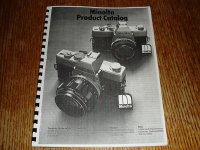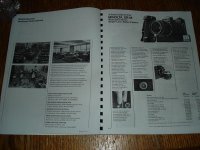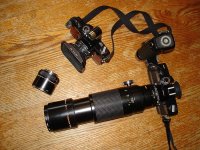Got my two SR-M bodies back today, now functioning like new, working smooth as butter. Greg Stelz did a fantastic job with both of these.
Went over to the Kiev Delphi Forums, and found these old comments, from my conversations with Fred DeVan, regarding the SR-M. Fascinating reading:
Hi Dan
I had a few of these. They are truly great ultra sturdy cameras. There is a bunch of nice gadgets that work with them. Radio Remotes, intervalometers, timers ect. They all are in a strange gray round can type enclosure (also worked on some Minolta Super8 cams) and also cords to remote the BattPack/Grip. The 250 exp. back is terriffic, and the grip dismounts to the bottom to make a super hand holdable package, via a unique bayonet adapter.
Contacts on rear curtin controls top motor speed. Rewind lever is also a reset, if the interlocks get confused. If you intend to use it a lot, find a spare batt holder, camera near useless if plastic teeth in batt pack are broken. They were only $10 when new.
This camera is nearly unbreakable. Internally, built like a tank.
Fred
Being built like a tank meant sizable parts, gears, solenoids, relays wires and motors. Batt consumption was not considered, so it is good but not great. Extra batt. magazines and almost instant change was the design philosophy I insisted on, hence the grip arrangement. The seeming illogic of having a tripod screw on the top of the grip makes total sense when you add the long roll back. If you find one make sure you get a trapezoidal quick release thingy with two ears sticking out with it. That thing is what goes into the screw hole on the top of the grip. The SR-M was the start of the Leitz-Minolta tech sharing which first showed itself in the XK and culminated with the XD-11. As nice as the CL was it was a logical manufacturing diversion from the hard stuff.
If you remember the Minolta Indy car Vels/Parnelli Jones sponsorship and the contest, books et al. that came along with it, that was my project, and the SR-M was central to it. I shot the Ads and most of the books and the traveling show with the SR-M. Also during those years I covered Indycar for Autoweek and SI, and the SR-M was the major tool for the all IndyCar and many CanAm, TransAm and Nascar races of the time and a raft of car, tire and product ads that resulted from them. I had a occasion to use all the accessories on one job in the 70's when I shot Sly Stone's (Sly and the Family Stone) wedding in Madison Square Garden for People Mag., where he and 25,000 of his closest friends put on a spectacle. The multi channel RC and intervalometres allowed me to shoot from 4 angles at once. All my assistants had to do was reload. The RC's managed the size of the place without hitch.
As you can tell I loved the SR-M and the thinking behind it came to full flower with the incomparable XK-Mot. The fullest expression of the Leitz/Minolta tie up is the XD-11. (Notice, Minoltas and Leicas all focus the same direction and the F-stop rings all match. That made using a mix of Minolta and Leica tolerable) That camera was the manual SLR perfected. It was a better built machine than anything on the market, but Minolta had not a clue just what they had. The very high price of the XK-Mot and XD-11 was actually justified if you could look under the hood but Minolta (like Olympus) marketing was focused on competing with Pentax and Yashica. Decidedly not in the same league. Superior products sold and really throttled down from what they could have been by inferior thinking. Really nice people with really dumb ideas. That is clearly seen in the Minolta 9000 of the late 80's.
If they only had a clue....was my only thought, every time when I was leaving the Minolta offices.
Fred
Hi Dan
The two years of the Minolta Car and Camera project was one of the highpoints of my life and the SR-M is a personal icon of it.Those really insane images that graced the cover of the 128 page freebie book, "How to photograph cars from start to finish" and the 8 ft high prints that were the highlight of the traveling show, shot from the middle of a 2.5 mile racetrack with 16mm and a 21mm lenses, with cars coming straight at the camera at speed was quite a event. Many thought they were a trick of some sort, but they were not. The drivers and I, dreamed it up the night before at dinner. On that day, Parnelli Jones had granted me a chance to finally get to drive an Indycar, and let me try a older, spare car. After a couple of hours of getting up to speed and following Joe Loenard around the track at 7/10 to get a feel of the groove, they all hid behind the wall and talked me thru everything as I took 10 laps at 9/10 speed. 10 laps at 200 MPH on an 2.5 mile oval quelled any continued interest in ever driving on an oval, that fast. I understood two things. I could do it comfortably, and I NEVER wanted to do it again. Yet, It was no where near as scary as driving across west Texas and New Mexico at 158 MPH in the real life, Cannonball race. (I finished sixth).
Al Unser, and Mario Andretti took bets as to whether my pants would be still dry, if I was lucky enough to survive. The next day, I had 2 SR-Ms with and stood on the track while talking to Al and Mario by radio directing them exactly how close to come to me when they drove by at about 110+ MPH. I had known Mario for years by then and Al was one of my best buddies at the tracks. I had to trust them and they had to know I was not crazy and was not going to move about. I also, had managed race teams, have a racing license and a number of pro races under my belt, so I knew how they and the cars would respond. Those huge prints were made under my supervision, from the original Kodachromes with no retouching or manipulation of any kind. Only the requisite 8x10 interneg was used. If you ever saw the incredible quality and sharpness those amazing prints you got a real confirmation of just how good this equipment was. In Many ways, the cameras and lenses of the time were better than most of what is being made today, it is for certain, we as photographers demanded more, than we do today.
P.S. I drove that Cannonball madness with an SR-M mounted behind me on the roll bar looking out the window and fired by a control at the steering wheel.
Fred
I probably did use the Batt. tester some but my situation was so abnormal that It seldom was an issue. Battery changing was not left to need, mostly,I had many of those inserts in my bag, and all cameras, meters, lenses, and radios were cleaned and checked every week. I shot so much film in so many cameras (20-40 rolls of 36 a day,Typ), plus I carried at least 2 of everything and had a duplicate kit at home. The motorized Leicas went thru batteries a bit faster than the SR-M's but to answer you correctly, it was never left to chance. I had a staff, a chef/motor home driver, a photo assistant, and a on track communications/sales rep. and everybody knew the camera maint. drill. So the 6 Minoltas, 4 Leicas, 4 Hasselblad's, Widelux, Nikon F, Nikonos, and all their attendant bits and pieces were given the same extraordinary loving care we provided for our indulgent taste buds. I snagged the chef from Pink Floyd on a F-1 trip, a mad Italian who loved food and racing, and savored the opportunity to have his insanity fully appreciated.
As I said it was totally abnormal. Minolta was not my only client. I started in magazines at Car and Driver, and by this time I shot every IndyCar race for Autoweek and filled the commercial needs of Goodyear and Firestone both (was on contract with Firestone), NGK, Gulf, BAT/B&W tobacco, Alfa, Ford, Nissan and Sports Ill. The SR-M was at the center of a photo factory focused on Indycar, Trans Am, Can Am, and Formula One.The film was air couriered to AutoWeek in Reno on Sunday Night and published or distributed by them on Monday. We usually did not see any of our output for weeks. Breakdowns were not permitted, and we had none.
The 21mm floating element 2.8 Rokkor was a masterpiece of optical engineering. There was nothing like it when it was created, and there have been few lenses with its capabilities since. There will never be anything like it again. Use it well.
Fred





